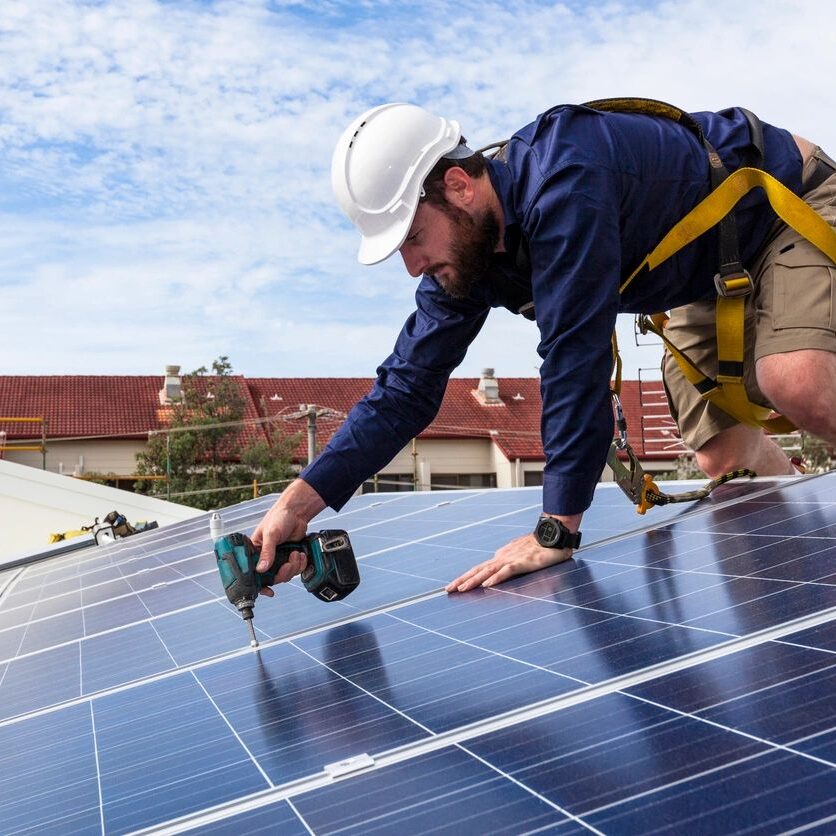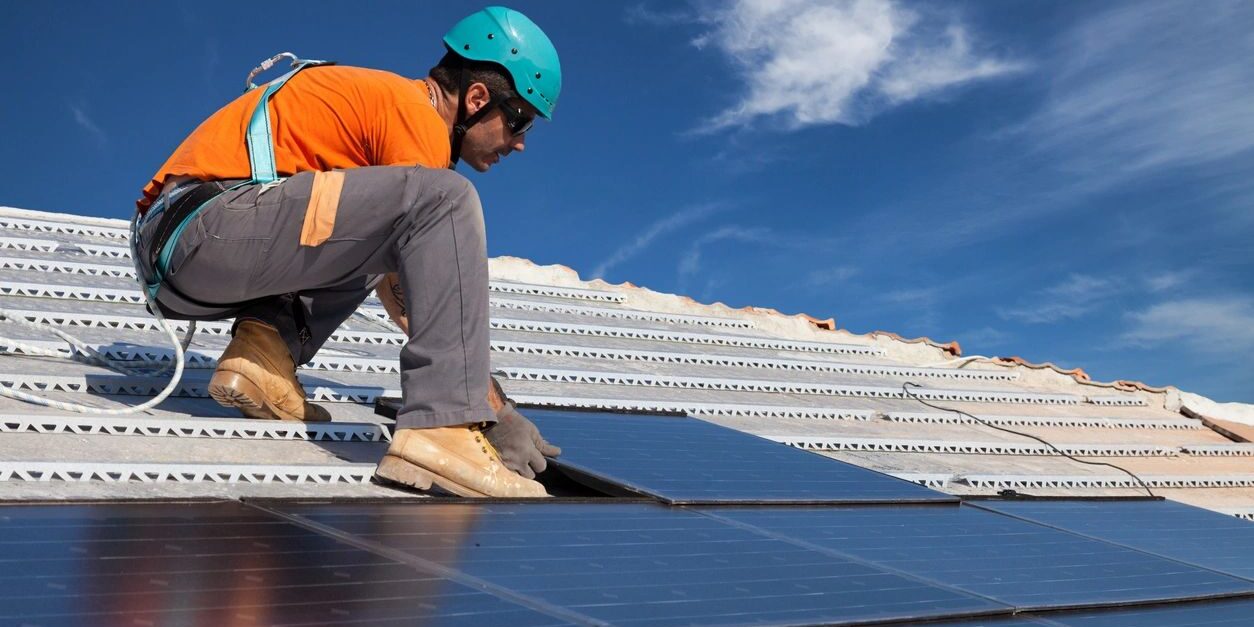Perhaps even before French physicist Edmond Becquerel discovered the photovoltaic effect with the first solar cell in 1839, the human race has attempted to harness the power of the sun. Many others built upon and improved solar technologies, so now individuals can have solar power systems that are reliable, efficient, cost-effective and environmentally friendly.
Today, 1SolarRite designs and installs solar power plants all over Southern California, allowing our customers to turn sunshine into usable electricity. Here’s a basic overview on how solar electric (photovoltaic) power technology works for both homes and businesses:
Free Sunshine
The Sun is an abundant energy source that showers the Earth with an immense amount of solar radiation every day.
When the photons in sunshine hit crystalline photovoltaic cells (as part of a solar panel), DC electricity is generated.
DC/AC Inversion
This DC electricity can be inverted to household AC power (usually operating in parallel with utility power, being grid- interconnected or “grid-tied”) so a building’s power needs are always met and completely seamless between the solar and utility, day or night.
Net-Zero
As a home or business will use an average number of kilowatt-hours per day, installing enough solar panels to harvest this same average amount will make the building net-zero. This is an ideal goal where you have all the reliability of being connected to a grid while offsetting your entire energy usage.
1- Harvesting sunshine is more cost-effective than paying the monopoly electric utility company for energy.
2- Solar uses US domestic energy (sunshine) that reduces the need for oil from unfriendly countries overseas.
3- 1SolarRite uses solar equipment from tire 1 and proven companies.
4- 1SolarRite is a US company staffed with the finest US solar professionals.
5- Today’s solar power equipment is advanced, mature technology providing the highest levels of efficiency and reliability expected by 1SolarRite customers.
6- Solar power panels are typically warranted for 25 years and have a lifecycle of 30+ years.
7- Using solar energy is a fast-growing part of the solution to meet our world’s future energy needs without using fossil fuels and significantly reducing many forms pollution.
8- With real-time, online system performance monitoring of solar production, you know what your system produces every day and every month, year by year.
9- The path to solar ownership is simple with no-money-down financing (with approved credit).
10- It’s fun to watch your meter spin backwards or negative numbers!
I'm concerned about the need to put holes in my roof to mount panels. Is this a potential risk for leaks?
In order to positively mount the panels to the roof, fasteners are necessary. Roof fasteners or penetrations are flashed to ensure a leak-proof installation for decades. By hiring a licensed and credentialed solar professional like 1SolarSystem, you can be certain your installation will be leak-free. In the case of standing-seam metal roofs and flat roofs, there are mounting systems that use compression hardware or ballast-type mounting systems that don’t require any holes to be drilled.
Will a PV system be able to run my air conditioner?
Yes, and much more. Today’s PV systems are tied into the main building service panel and provide power to the whole house rather than just one appliance. This is much more efficient, because if the AC is not running, the solar power dedicated to it would otherwise be wasted. We are less concerned about “power output” at any given time (as the intensity of the sun varies throughout the day), but more interested in “energy harvest” in a given month, or more specifically, electric utility billing cycle. So rather than getting excited your system is showing 8,000 watts of power at noon, you’ll be happier that you harvested 1,400 kilowatt-hours for the month and got an electric bill totaling $10 instead of $200.
What maintenance is required?
For grid-tied PV systems with no batteries, the only maintenance required is an occasional cleaning of the dirty panels (which produce less power), with clean panels ensuring maximum performance. Cleaning frequency is a function of how fast they accumulate dirt (known as “soiling” in solar terms). With no moving parts, solar panels do not wear out. For battery back-up systems, an annual battery inspection and test is also recommended. We provide services to clean solar panel arrays and inspect battery systems.
Do all PV systems require batteries?
No. Over 95% of PV systems installed do not utilize batteries. Where utility power is available and reliable, adding batteries adds significant costs. Where utility power is not available, off-grid battery systems are a better option than noisy, polluting generators that require regular fuel runs. In all cases, a battery back-up system can be added to a grid-tied system at any time. Note that grid-tied PV systems (no batteries) can be installed in conjunction with automatic back-up generators to have the best of both worlds.
Should I consider heating my hot water with solar (thermal) panels?
Solar water heaters have been popular for decades in California as a way to off-set the cost of heating water typically with electricity or gas. There have been many incentives to reduce the cost of solar water heating, making it a viable cost-effective purchase, particularly for large families with high hot water usage. As 1SolarRite is focused on maximum benefit to customers, we typically DO NOT recommend solar water heating to households of 4 or less. Although we do strongly believe in solar water heating technology, we also believe the newest hybrid heat pump water heaters provide better value to our customers because it reduces water heating costs by about 60% (solar is about 85%) but only costs a fraction of a solar water heater. We believe our customers are best served with grid-tied PV systems in conjunction with a hybrid heat pump water heater in pursuit of a cost-effective net-zero home energy goal. In situations where large amounts of hot water is used on a daily basis (5+ person households) a solar water heater will typically provide more attractive economics than any other form of water heating.
Will a PV system make my meter spin backwards?
It depends on your building’s demand at specific times. If your PV system is generating more power than your building is consuming (which happens often), then YES. Your meter will spin backwards proportional to the amount of power being fed back into the grid. If your building’s electrical load is more that the PV power output, then NO. The meter will not spin backwards, but it will be SLOWED proportionally to the power output.
Will having solar panels ensure I have power if the utility company has a power failure?
Grid-interconnected (or grid-tied) PV systems with no batteries or generator are designed to shut down if the utility power goes out. This is a safety requirement by law to ensure the PV doesn’t back-feed the utility lines and put utility workers at risk. If the PV is designed with battery back-up and/or a generator, then back-up power will be available when utility power goes out.
Should I consider heating my pool with solar pool panels?
Solar pool heaters have been popular for decades in California as a low-cost way to extend the pool season. Due to the large amount of roof area required for solar pool panels, many customers are moving away from solar pool heating systems to use that same area to make electricity with PV panels, then installing electric heat pump pool heaters to boost water temperatures when needed. Ironically, it is generally more cost effective to go this route because the PV panels are making electricity everyday and the heat pump is only used for short periods — the same amount of time the solar pool panels would be needed, wasting 10 out of 12 month for making electricity.
How do I get a price for a solar power system?
Making a solar purchase is much different than buying a major kitchen appliance, because each system must be sized specifically for the energy demand. As every house and building is different, multiple factors go into sizing and pricing a system. By having 1SolarRite conduct an energy analysis, you can be confident in having a properly designed and installed system to provide you with reliable energy generated by a renewable source, for decades to come. Call 949-324-3590 or email (info@1solarrite.com) us to schedule a consultation today.
Financing a solar installation can make it easy to start saving money without delay or any up-front costs. We have several financing options, both secured and unsecured programs, with terms rom 5 years up to 20 years. As solar power systems have an expected life cycle of 30 to 40 years of benefits, it can make financial sense to spread the initial cost over time. In many cases your monthly savings can match or exceed the loan payment for immediate positive cash flow.
For new construction or new home buyers, it makes perfect sense to finance a solar system with a 30 year mortgage, as this typically makes a strong positive cash flow scenario.
Financial Incentives and Resources
With current solar incentives, the initial solar investment cost is drastically reduced, accelerating return-on-investment and payback scenarios. These generous state rebates (battery) and federal tax credits make it a great time to invest in solar.
Until recently, the cost of installed solar power systems required some kind of financial incentive to make the economics work. Now we have found that even not-for-profit entities (which cannot use IRS tax credits) have favorable economics to purchase solar systems, depending on electric rates and system size.
Step 1
Initial Onsite Consultation
We will meet with you to determine your wants and needs, evaluate your roof and energy bills, and then design a system to address your desires. We will also provide financing options and assist with loan pre-approvals. This is a free, no-obligation consultation.
Step 2
Contracts & Approvals
Once you decide to move forward, our engineers will review your system’s layout and electrical requirements. We take care of everything else. We will submit the project for local permitting, contacting local utilities and submit an application to your homeowner’s association, as needed. This approval process typically takes a few weeks, and we order your equipment during this period. Once all permits are received and equipment on-hand, we will schedule your installation date.
Step 3
Installation Day
Sometime between 8:00 and 8:30 AM, a 1SolarRite truck with crew will arrive to begin work. The project manager will introduce himself, and he will answer any of your questions. Note: Please ensure any items blocking your electric panels are out of the way. Once the last panel is installed, we will turn on your system for testing.
Step 4
Inspections
The local authority having jurisdiction (AHJ), usually the city government, will inspect your new system. Afterwards, the utility company will inspect our work as well and request for a new electric meter designed specifically for solar systems.
Step 5
PTO
Within about a week, your utility company will issue PTO (Permission To Operate).
Step 6
Your New Power System
With your new solar system in place, you start making your own electricity for years and decades to come.


